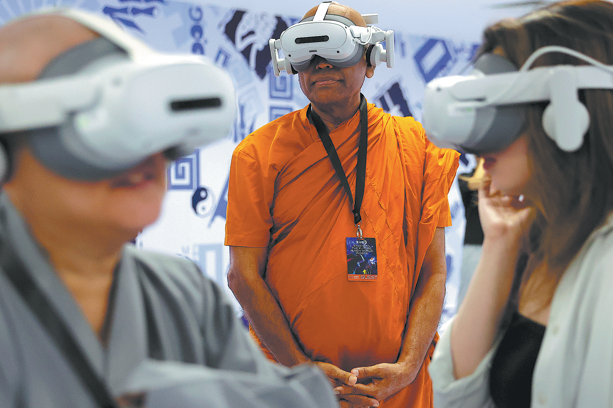Digital tech adds new dimension to history
China Daily | Updated: 2023-05-24 07:59
With a rich cultural heritage, Central China's Henan province is one of the birthplaces of Chinese civilization. Henan Museum, located in the province's capital city of Zhengzhou, welcomed more than 70,000 visitors during the May Day holiday. Yu Ru was one of them. She traveled all the way from Beijing to learn more about the ancient history of the Central China Plains area.
"The museum is like a sand table of history; it presents the development of the city's civilization through cultural relics," she says.
In recent years, there has been a growing appreciation of fine traditional culture among Chinese people, with museum visits increasing in popularity.
By 2021, China was home to 6,183 museums that had been registered with authorities, with 90 percent of them offering free admission, according to the National Cultural Heritage Administration.
"Visiting museums can help us better understand traditional culture, enhance cultural confidence and gain insight into the future," says An Laishun, vice-president of the Chinese Museums Association.
With the rise of modern technology, more high-tech methods have been used to present treasured relics, providing easier access and better experiences to the nation's culture vultures.
Fahai Temple in Beijing was first built in 1439, and is noted for its frescoes. The murals are still vibrant after nearly 600 years, but those who want a clearer picture of their original magnificence might not feel satisfied.
By applying digital technology to cultural relics, an immersive digital art gallery was created earlier this year. At the exhibition of Fahai Temple Mural Art Center, the original scale of mural paintings was presented with a 4K HD display. Each one of the 77 figures was portrayed with immaculate attention to detail by pixel-level 3D modeling.
The facial details of Water-moon Avalokitesvara, one of the most representative figures on the frescoes of Fahai Temple, are hard to make out in dim, real-world conditions. However, after 3D modeling, the face of the 3-meter-tall figure can be seen clearly on the 4K HD screen at the Mural Hall in the basement of the art center.
China has proposed promoting the free opening and digitalization of public cultural venues and the development of online digital experience products and new cultural tourism services, such as immersive tours, virtual exhibitions and high-definition live broadcasts, during the 14th Five-Year Plan period (2021-25).
Apart from attracting people to visit exhibitions, museums in China have also explored social education activities through various means to create "mobile museums".
With the help of livestreaming platforms, a museum in Beijing held an online course last month for primary school students in Qinghe county in North China's Hebei province, which is located more than 360 kilometers from Beijing.
Children in rural areas rarely have the opportunity to visit museums, and we hope to provide more resources to them through online courses, says Li Jing from the eastern suburbs exhibition hall of China Railway Museum.
According to data from the Ministry of Culture and Tourism, museums nationwide held 36,000 exhibitions and more than 320,000 education activities in 2021.
"Museums should share their historical and cultural resources with society, and work together with schools and communities so that people can learn more about history and enhance their cultural identity," says An.
Xinhua
























